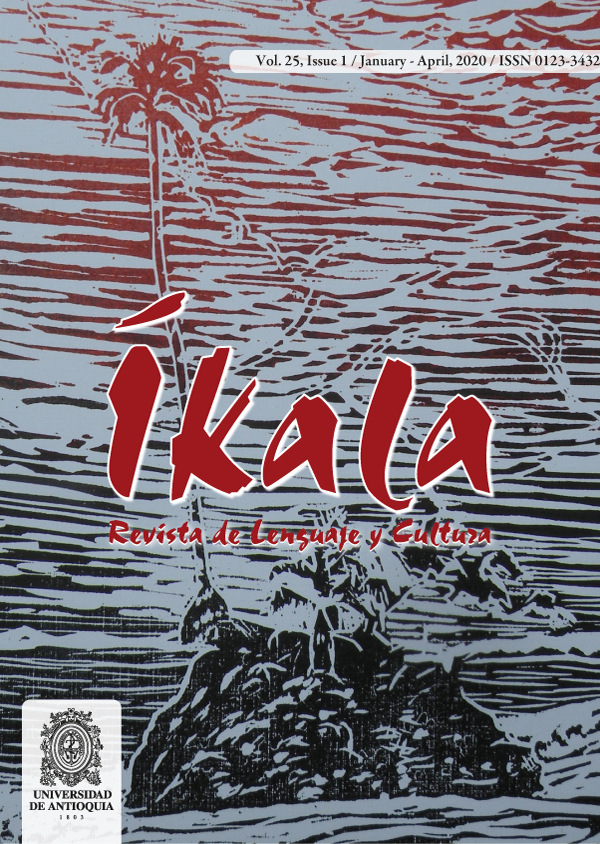Pre-modern English Identity and Roman Otherness in Shakespeare’s Cymbeline: Some Gender-based Considerations
DOI:
https://doi.org/10.17533/udea.ikala.v25n01a12Keywords:
Roman ethos, English identity, Roman history play, Cymbeline, Skakespeare.Abstract
This paper aims at characterizing Shakespeare’s Cymbeline relying upon some aspects featured by Shakespearean Roman history genre, as those reveal various tensions between the English premodern identity and the Roman ethos, which was considered an imperialist model by Jacobean and Elizabethan England. This analysis is carried out from a revisionist historical perspective of premodern England, and from the idiosyncratic framework of Shakespearean Roman history plays. It is concluded that Cymbeline displays an ironic dialectics between the double canon of Roman ethos, romanitas and pietas, positioning it as contradictory and detrimental for the social health of the body politics. Shakespeare’s Rome in Cymbeline represents the contrary to the idealized model used by Elizabethan imperial propaganda in the process of construction of their national poiesis.
Downloads
References
Alexander, M. (1979). An introduction to Shakespeare and his contemporaries. London: Pan Books.
Asquith, C. (2005). Shadowplay. The hidden beliefs and coded politics of William Shakespeare. New York: PublicAffairs.
Bazerman, C. (1994). Constructing Experience. Illinois: Illinois University Press.
Bergeron, D. (1980). Cymbeline: Shakespeare’s Last Roman Play. Shakespeare Quarterly, 31, (1), 31-41.
Bloom, H. (2001). Shakespeare. La invención de lo humano. Colombia: Editorial Norma.
De Aguiar e Silva, V. (2005). Teoría de la literatura. España: Gredos.
Bonandella, P. (1987). The Eternal City. Roman Images in the Modern World. North Caroline: The University of North Caroline Press.
Dionis-Bayer, M. ed. (2001). Antonio y Cleopatra. Madrid: Cátedra Letras Universales.
Evans, B. (1960). Shakespeare’s comedies. Oxford: The Clarendon Press.
Fletcher, J. ed. (1968). Cymbeline. USA: A Signet Classic.
Frye, N. (1968). The Tragedy of Order: Julius Caesar. En Dean, L. (ed) Twentieth century interpretations of Julius Caesar (pp.95-102). London: Prentice-Hall.
Frye, N. (1968). Cymbeline. From A natural perspective. En Barnet, S. (ed.) Cymbeline, (pp.237-241). USA: Signet Classic.
Green, A. (2005). Sortilegios de la seducción. Buenos Aires: Paidós Diagonales.
Greenblatt, S. (1988). Representing the English Renaissance. USA: University of California Press.
Halio, J. (1992). The late plays and the fulfillment of Shakespeare’s tragic pattern. En Hunt, M. (ed) Approaches to teaching Shakespeare’s The tempest and other late romances (pp. 31-38). New York: The Modern Language Association of America.
Halliday, F. (1985). Shakespeare. London: Thames & Hudson.
Hibbert, C. (2005). Rome. The Biography of a City. London: Penguin Books.
Hosley, R. (ed.) (1968). Cymbeline. Canada: Signet Classic.
Ingledew, J. (1987). Antony and Cleopatra. Singapur: Longman.
Johnson, S. (1765). Prefacio a Shakespeare. Disponible en
https://es.scribd.com/document/258850022/Prefacio-a-Shakespeare-Samuel-Johnson
Kahn, C. (1987). Roman Shakespeare. Warriors, wounds and women. London: Routledge.
Khun, T. (1990). La estructura de las revoluciones científicas. Buenos Aires: Fondo de Cultura Económica.
Lee, K. (2001). Shakespeare’s England, Shakespeare’s Rome: National anxiety and imperial nostalgia. Medieval and Early Modern English Studies, 15 (2), 395-418.
Miola, R. (1983). Shakespeare’s Rome. London: Cambridge University Press.
Monney, M. (1992). Defining the dramaturgy of the late romances. En Hunt, M. (ed) Approaches to teaching Shakespeare’s The tempest and other late romances (pp. 57-63). New York: The Modern Language Association of America.
Pieters, J. (2001). Moments of negotiation. Amsterdam: Amsterdam University Press.
Piña, C. (ed) (2007). Cimbelino. Buenos Aires: Losada.
Puchmüller, A. (2007). Los dramas histórico romanos de Shakespeare: Lugar, competencia e identidad. Actas del IV Simposio Nacional Ecos de la Literatura Renacentista Inglesa, Facultad de Filosofía y Letras. Universidad Nacional de Cuyo. Mendoza, 19-24.
Reale G. y Antiseri, D. (1999) Historia del pensamiento filosófico y científico. Tomo II. Barcelona: Herder.
Roldán, J. (1995). Historia de Roma. Tomo I. Madrid: Ediciones Cátedra.
Ronan, C. (1995). Antike Roman. Power symbology and the roman play in early modern England, 1585-1635. USA: The University of Georgia Press.
Shakespeare, W. Cymbeline. Editado por Fletcher, J. (1968). USA: A Signet Classic.
Shakespeare, W. Antonio y Cleopatra. Editado por Dionis-Bayer, M. (2001) Madrid: Cátedra Letras Universales.
Spenser, T. (1957) Shakespeare and the Elizabethan Romans. London: Cambridge University Press.
Steible, M. (2004). Coriolanus. Connecticut: Greenwood Press.
Swander, H. (1964). “Cymbeline and the Blameless Hero”. ELH, Vol. 31, No. 3, pp. 259-270.
Thomas, V. (1991). Shakespeare’s Roman worlds. London: Routledge.
Tillyard, E. (1943). The Elizabethan World Picture. London: Random House.
Todorov, T. (1976). The origin of genres. USA: New Literary History.
Torres Mari, F. (1982) Filosofía y Literatura: Emoción y Razón en Troilus and Cresida de W. Shakespeare. RACO (Revistas Catalanas con Acceso Abierto) Universidad de Cataluña. 201- 215. Recuperado el 15/04/08 de http://www.raco.cat/index.php/Caligrama/article/view/66622
Waller, G. (1992). The late plays as family romance. En Hunt, M. (ed) Approaches to teaching Shakespeare’s The tempest and other late romances (pp. 57- 64). New York: The Modern Language Association of America.
Published
How to Cite
License
Copyright (c) 2020 Íkala

This work is licensed under a Creative Commons Attribution-NonCommercial-ShareAlike 4.0 International License.












